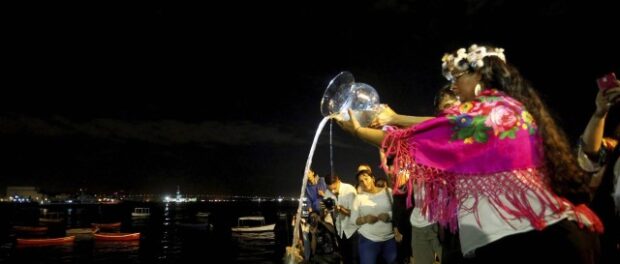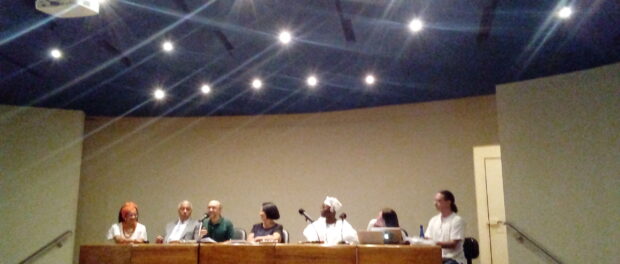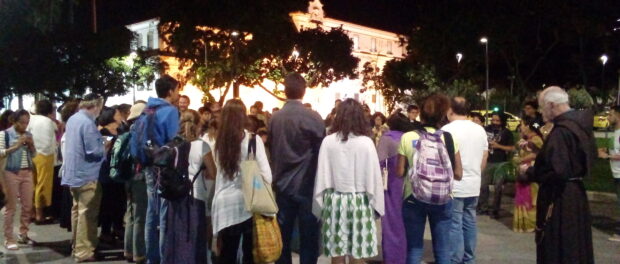
The universal importance of water was the root of the May 3 Dialogues: Faith in Climate – Sacred Waters event, hosted by the Institute for the Study of Religion (ISER) at Brazil’s National History Museum. Wednesday afternoon’s program was public, but made up part of Fé no Clima (Faith in Climate), an interfaith conference for religious leaders and youth from across the Americas. The program included a presentation on the history of activism in Rio’s Guanabara Bay by researcher Breno Herrera, an interfaith dialogue including leaders in the Umbanda, Evangelical, Jewish, Presbyterian, and Yoruba communities, and an interfaith water ceremony and walk to the Guanabara Bay with the participation of even more religious traditions.
The conference began with Herrera’s presentation on the effects of ecological damage on the fishermen of the Guanabara Bay, made world famous by extreme pollution levels threatening Olympic athletes, but once visited by Charles Darwin who wrote in 1823 that the “Guanabara Bay exceeds in its magnificence everything the European has seen in his native land.”
Herrera cited the 2000 oil spill as a major setback for the Bay’s fishing industry. The fishermen have not yet been compensated for the damage, and the perpetrators have not been brought to justice. However, the oil spill also spurred the formation of the Men’s and Women’s Guanabara Bay Association or AHOMAR (Associação Homens e Mulheres do Mar da Baía de Guanabara), the association of fishermen that protested and advocated for larger fishing zones and fewer sources of contamination, such as that from the Comperj petrochemical factory. The resistance has been fierce, and so has the response of business interests such as Brazil oil firm Petrobras—fishermen staged boat “sit-ins” on industrial infrastructure in the bay, and four activists were murdered during the resistance. Those demonstrations continued until 2013—and with the help of media pressure, Petrobras changed its policy. AHOMAR is still active as the fishing community faces new challenges in the Guanabara Bay.
Herrera explained that as a practicing Catholic, he finds that his work intersects with Pope Francis’ ecological philosophy—that the preservation of nature isn’t just for the privileged who seek to protect only its aesthetic beauty, but for everyone, because environmental degradation is a threat to public health, traditional ways of life, and access to basic needs, including clean water. Corporate domination can bring with it environmental degradation and commodification of these immeasurably valuable elements. Herrera believes that in spite of its history, the Guanabara Bay has the potential to be a place where “ecology and social justice can meet.”
Audience members shared stories and experiences of their communities, echoing many of the themes of oppression and resistance of AHOMAR’s struggle in the Guanabara Bay. Herrera gave advice to the audience for resisting, stressing organization, participation, and protagonism: “It’s fundamental that the affected communities get to know the group, get to know the community, and form a movement, an organization, an association.. these affected [fishing] communities were invited to participate directly in the process of licensing, undertaking, that would come to affect [them].” To Herrera, protagonism means that “the participation of these groups cannot be supplementary participation… An academic can provide scientific information, and strengthen the struggle, and religious people can offer spiritual and existential support, but never in substitution of the voice of the affected themselves. We never really hear from those who know the most.”
Herrera also called for “pay(ing) special attention to indigenous communities,” as these communities have been managing ecosystems sustainably throughout history. However, Herrera makes the important distinction that this “special attention” not take the form of placing the full burden of a region’s ecological issues on its indigenous communities.
Herrera’s talk was followed by a panel discussion with domestic and international community leaders: Babalorixá Kola Abimbola, of the Yoruba community in Nigeria, Mãe Flávia Pinto of the Umbanda community in the state of Rio de Janeiro, Pastor Ariovaldo Ramos of the Evangelical community in São Paulo, Pastor and eco-theologian Neddy Astudillo of the Presbyterian community in the United States, and Diane Kuperman, of the Jewish community in Rio de Janeiro. The speakers discussed the role of water as it relates to their faiths, and in doing so, realized that in all of the denominations, water is an integral part of both spiritual practice and ritual as well as the faith’s overall philosophy of Earth, creation, and the physical world.
Pastor Ramos explained that “water is the instrument of practicing rituals” and that its physical form is a “symbol of the universality of God.” Babalorixá Abimbola explained how the Yoruba’s “Orixá religion is actually the worship of nature,” and that water’s physical form also represents its universality—the concept of dividing the oceans goes against Orixá philosophy. Abimbola shared an Orixá “swallower story,” which stressed the importance of respect for nature. Kuperman explained that in the Jewish faith, water is present even before creation, demonstrating its spiritual and physical importance. For the Presbyterian representative, Astudillo, “[God] manifests himself in nature” so respect and piety for ecosystems and the environment is requisite for respect of the divine. Mãe Pinto, a representative of the local Umbanda community and leader of Casa do Perdão explained that if water is impure, the energy of a water-based ritual is compromised. She explains that making sure the environment is clean also relates to practicing Umbanda spirituality: “When we make an offering to the Orixá… we don’t throw things in the trash, but return them to nature so that the cycle is lived once again. Naturally, this also affects our offerings in relation to water. In this way we never practice acts of offering with polluting elements in them, such as perfume, champagne, mirrors, anything like that.”
Beyond establishing the common spiritual motive of water conservation, many panelists also described the political and social issues related to water in their communities. Pinto explained that simply having a rainwater harvesting system at Casa do Perdão has greatly increased public awareness of the issue of clean water and water conservation by demonstrating how much water is needed for their daily use. Similarly, she hopes that future business leaders will be able to channel their spiritual values in making social and ecologically responsible decisions. She explained how her community takes part in beach and waterfall cleanups as well.
Abimbola rejected the categorization of water as a “resource,” because the term ignores that it is above all “the source of life.” Panelists and audience members expressed strong opposition to growing privatization of water around the world and the subjection of elements of nature to a fluctuating market. The relationship of foreign business interests and privatization was also referenced as an obstacle in the struggle for community water rights. Many of the panelists were pursuing faith-based clean water and human rights projects in addition to religious work, highlighting the inevitable political element of their spirituality-based struggle.
Once the panel was over, the group convened in the museum’s courtyard for an interfaith water ceremony. To begin, the audience was led in a rendition of “Planeta Água.” Panelists and attendees had each filled a small bottle from a local body of water in their hometown, and one at a time poured this water into a large glass urn, naming its place of origin. The urn, filled with water from a wide range of sites in the Americas, perfectly embodied the diverse origins of the young attendees at the conference, their shared vision of global access to water, and the universality of water’s physical form.
To conclude, the conference attendees and religious leaders walked to the Guanabara Bay together, passing the urn among different leaders. The group stopped along the way to participate in water-based rituals led by different faiths, including Buddhist, Wicca, and indigenous Fulni-ô tradition. The ceremony culminated at the Guanabara Bay where attendees poured the water in the urn into the bay, integrating themes of environmental justice in the Guanabara Bay with the various rituals and prayers presented.
During her talk, Pinto emphasized that it is so easy to talk about issues, but acting is extremely important for conveying the message to others—“I am only saying that it is beautiful sometimes to sit and talk, but it is difficult to share a message in this case… so creating environmental consciousness is not an easy task.” However, Wednesday’s talks demonstrated that young people who return home looking to act on water rights issues can engage their religious and interfaith communities as networks for organizing and support.



